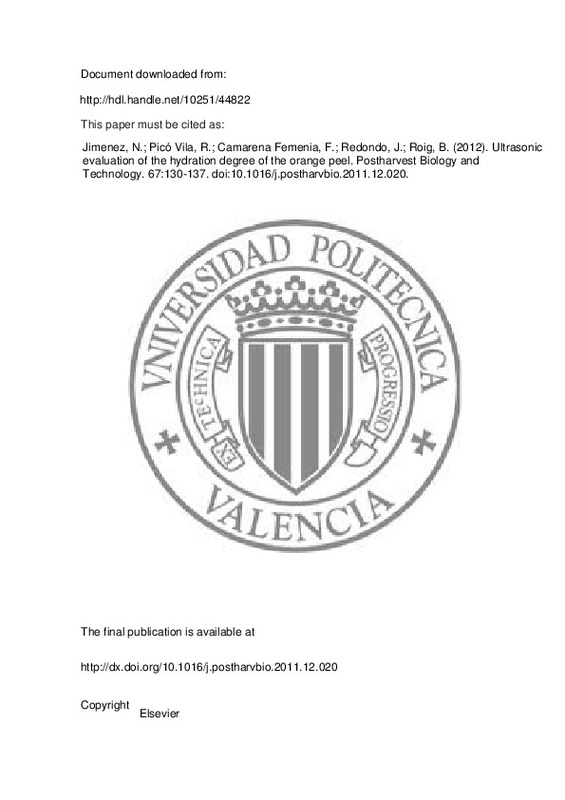JavaScript is disabled for your browser. Some features of this site may not work without it.
Buscar en RiuNet
Listar
Mi cuenta
Estadísticas
Ayuda RiuNet
Admin. UPV
Ultrasonic evaluation of the hydration degree of the orange peel
Mostrar el registro sencillo del ítem
Ficheros en el ítem
| dc.contributor.author | Jimenez, Noe
|
es_ES |
| dc.contributor.author | Picó Vila, Rubén
|
es_ES |
| dc.contributor.author | Camarena Femenia, Francisco
|
es_ES |
| dc.contributor.author | Redondo, Javier
|
es_ES |
| dc.contributor.author | Roig, Bernardino
|
es_ES |
| dc.date.accessioned | 2014-11-25T15:07:19Z | |
| dc.date.available | 2014-11-25T15:07:19Z | |
| dc.date.issued | 2012-05 | |
| dc.identifier.issn | 0925-5214 | |
| dc.identifier.uri | http://hdl.handle.net/10251/44822 | |
| dc.description.abstract | The elastic parameters of fruit and vegetables are normally monitored in quality control processes as there is a good correlation to the degrees of firmness, turgidity and humidity. These parameters have been traditionally measured by means of penetration tests, which are destructive. This has resulted in the increased attention recently given to ultrasonic techniques applied to the quality evaluation of horticultural commodities. Nevertheless, since most of the fruit and vegetables display a viscoelastic behavior, the penetration test should be considered to be quasi-static, especially when compared with the speeds associated with the ultrasonic tests. Both methods should provide different values for the elastic parameters. The aim of this work is to study this discrepancy in the values of the elastic parameters and interpret the elastodynamic behavior of the vegetable tissue under an ultrasound test. Thus, the paper presents an ultrasonic nondestructive method to evaluate the elastic parameters of the sweet orange peel at 40. kHz. The complete dehydration process of two sets of oranges (Navelina and Ortanique) was monitored for 2. months. A linear elastic solid model with viscous losses was numerically solved using a simulation scheme based on a 3D-Spherical FDTD method (Finite-Difference Time-Domain) in order to interpret the results, which proved that the elastic parameters obtained by penetration and ultrasonic tests differ. The method provides an empirical relation between the hydration state and the elastic parameters of the orange peel. Therefore, the proposed ultrasonic test reported in this work is capable of determining the hydration state of the orange simply by measuring the propagation speed of the Rayleigh waves on the orange peel, and hence, can be used as a fruit quality index during postharvest processes. © 2012 Elsevier B.V. | es_ES |
| dc.description.sponsorship | This study was supported by the Programa de Apoyo a la Investigacion y Desarrollo (PAID-05-09-002-618), (PAID-06-10-002-295) of Universidad Politecnica de Valencia. The authors would like to thank K. Y. Foo, from the University of Birmingham and P. Malischewsky from the University Friedrich-Schiller at Jena, for the fruitful discussions regarding surface acoustic waves. | en_EN |
| dc.language | Inglés | es_ES |
| dc.publisher | Elsevier | es_ES |
| dc.relation.ispartof | Postharvest Biology and Technology | es_ES |
| dc.rights | Reserva de todos los derechos | es_ES |
| dc.subject | Elastodynamic | es_ES |
| dc.subject | Finite-Differences Time-Domain, FDTD | es_ES |
| dc.subject | Hydration degree | es_ES |
| dc.subject | Orange peel | es_ES |
| dc.subject | Postharvest quality | es_ES |
| dc.subject | Rayleigh wave | es_ES |
| dc.subject | Ultrasound | es_ES |
| dc.subject | Young modulus | es_ES |
| dc.subject | Citrus sinensis | es_ES |
| dc.subject.classification | MATEMATICA APLICADA | es_ES |
| dc.subject.classification | FISICA APLICADA | es_ES |
| dc.title | Ultrasonic evaluation of the hydration degree of the orange peel | es_ES |
| dc.type | Artículo | es_ES |
| dc.identifier.doi | 10.1016/j.postharvbio.2011.12.020 | |
| dc.relation.projectID | info:eu-repo/grantAgreement/UPV//PAID-06-10-002-295/ | es_ES |
| dc.relation.projectID | info:eu-repo/grantAgreement/UPV//PAID-05-09-002-618/ | es_ES |
| dc.rights.accessRights | Abierto | es_ES |
| dc.contributor.affiliation | Universitat Politècnica de València. Instituto de Investigación para la Gestión Integral de Zonas Costeras - Institut d'Investigació per a la Gestió Integral de Zones Costaneres | es_ES |
| dc.contributor.affiliation | Universitat Politècnica de València. Departamento de Física Aplicada - Departament de Física Aplicada | es_ES |
| dc.contributor.affiliation | Universitat Politècnica de València. Departamento de Matemática Aplicada - Departament de Matemàtica Aplicada | es_ES |
| dc.description.bibliographicCitation | Jimenez, N.; Picó Vila, R.; Camarena Femenia, F.; Redondo, J.; Roig, B. (2012). Ultrasonic evaluation of the hydration degree of the orange peel. Postharvest Biology and Technology. 67:130-137. https://doi.org/10.1016/j.postharvbio.2011.12.020 | es_ES |
| dc.description.accrualMethod | S | es_ES |
| dc.relation.publisherversion | http://dx.doi.org/10.1016/j.postharvbio.2011.12.020 | es_ES |
| dc.description.upvformatpinicio | 130 | es_ES |
| dc.description.upvformatpfin | 137 | es_ES |
| dc.type.version | info:eu-repo/semantics/publishedVersion | es_ES |
| dc.description.volume | 67 | es_ES |
| dc.relation.senia | 220032 | |
| dc.contributor.funder | Universitat Politècnica de València | es_ES |







![[Cerrado]](/themes/UPV/images/candado.png)

